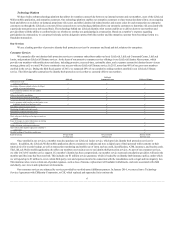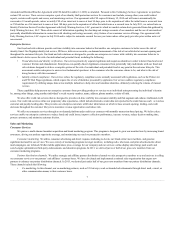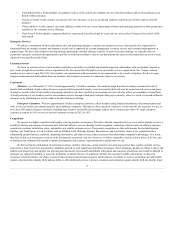LifeLock 2013 Annual Report Download - page 19
Download and view the complete annual report
Please find page 19 of the 2013 LifeLock annual report below. You can navigate through the pages in the report by either clicking on the pages listed below, or by using the keyword search tool below to find specific information within the annual report.
•bad publicity and other issues faced by our strategic partners could negatively impact us; and
•our strategic partners, some of which already compete with us, may present increased competition for us in the future.
Our inability to maintain our existing and secure new relationships with strategi c partners could harm our revenue and operating results.
Many of our key strategic partnerships are governed by agreements that may be terminated without cause and without penalty by our strategic partners
upon notice of as few as 30 days. Under many of our agreements with strategic partners, our partners may cease or reduce their marketing of our services at
their discretion, which may cause us to lose access to prospective members and significantly reduce our revenue and operating results.
Some of our strategic partners possess significant resources and advanced technical abilities. Some offer services that are competitive with our services
and more may do so in the future, either alone or in collaboration with other competitors. Those strategic partners could give a higher priority to competing
services or decide not to continue to offer our services at all. If any of our strategic partners discontinue or reduce the sale or marketing of our services, promote
competitive services, or, either independently or jointly with others, develop and market services that compete with our services, our business and operating
results may be harmed. In addition, some of our strategic partners may experience financial or other difficulties, causing our revenue through those strategic
partners to decline, which would adversely affect our operating results.
In order for us to implement our business strategy and grow our revenue, we must effectively manage and expand our relationships with qualified
strategic partners. We expend significant time and resources in attracting qualified strategic partners, training those partners in our technology and service
offerings, and then maintaining relationships with those partners. In order to continue to develop and expand our distribution channels, we must continue to
scale and improve our processes and procedures that support our strategic partnerships. Those processes and procedures could become increasingly complex
and difficult to manage. Our competitors also use arrangements with strategic partners, and it could be more difficult for us to maintain and expand our
distribution channels if they are more successful in attracting strategic partners or enter into exclusive relationships with strategic partners. If we fail to
maintain our existing or secure new relationships with strategic partners, our business will be harmed.
ID Analytics has historically derived, and continues to derive, a significant portion of its revenue from a limited number of enterprise customers. For
example, in 2013, 2012, and 2011, sales derived through ID Analytics’ top ten customers accounted for approximately 65%, 70%, and 65%, respectively, of
ID Analytics’ revenue for those periods. Some of these customers also provide services that compete with our consumer services and, accordingly, may seek
alternative identity risk and credit worthiness assessment services in the future. The loss of several of our enterprise customers, or of any of our large
enterprise customers, could have a material adverse effect on our revenue and results of operations, as well as the efficacy and attractiveness of the LifeLock
ecosystem.
In addition, new customer acquisition in our enterprise business is often a lengthy process requiring significant up-front investment. Accordingly, we
may devote substantial resources in an effort to attract new enterprise customers that may not result in customer engagements or lead to an increase in revenue,
which could have a material adverse effect on our business.
Our operations depend upon our ability to protect the telecommunications and information technology systems utilized in our services against damage
or system interruptions from natural disasters, technical failures, human error, and other events. We send and receive credit and other data, as well as key
communications to and from our members, electronically, and this delivery method is susceptible to damage, delay, o r inaccuracy. A portion of our business
involves telephonic customer service and online enrollments, which depends upon the data generated from our computer systems. Unanticipated problems
with our telecommunications and information technology systems may result in data loss, which could interrupt our operations. Our telecommunications or
information technology infrastructure upon which we rely also may be vulnerable to computer viruses, hackers, or other disruptions.
We rely on our network and data center infrastructure and internal technology systems for many of our development, operational, support, sales,
accounting, and financial reporting activities. We routinely invest resources to update and improve these systems and environments with the goal of better
meeting the existing, as well as the growing and changing requirements of our customers. If we experience prolonged delays or unforeseen difficulties in
updating and upgrading our systems and a rchitecture, we may experience outages and may not be able to deliver certain service offerings and develop new
service offerings and enhancements that we need to remain competitive. Such improvements and upgrades often are complex, costly, and time consuming. In
addition, such improvements can be challenging to integrate with our existing technology systems or may result in problems with our existing
16
























